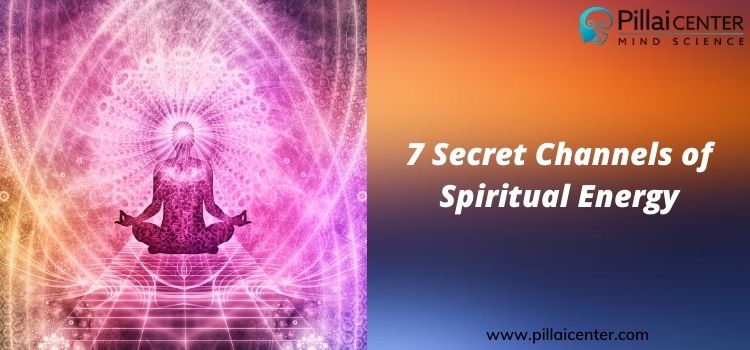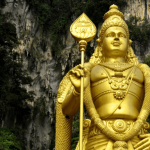Introduction to Chakras
Chakra is a Sanskrit term referring to a ‘Disc” or “Wheel.” The concept of seven chakras is an ancient philosophy belonging to Hinduism; the continuous flow of energy through the chakras is known as “Kundalini Shakti.” When activated, these seven chakras act as seven secret channels of spiritual energy.
These seven chakras are found in our bodies but are not visible to our naked eye. Each of the chakras is associated with a unique color, symbol, and God. The Chakras are situated along the spine and are capable of influencing different nerve systems, organs, and glands.
It is believed that the chakra energy (Kundalini Shakthi), while in the dormant state, it is spiral at Mooladhara chakra (the base of the spine). The Shakti flows from one chakra to another based on your spiritual practices and focus. The ultimate spiritual goal prescribed by the shastras is to awaken and release the Kundalini Shakthi to attain a greater consciousness and merge it with the Brahman.
When one practices meditation and Kundalini yoga correctly with a guru’s guidance, the energy lying dormant in the Muladhara chakra will pass back up the spine until it reaches the top of the head. As a result, a spiritual practitioner will undergo a mystical religious experience.
The seven chakras
The following is the list of chakras and the information related to their characteristics and their qualities.
1. Muladhara: This is the Root Chakra, located at the base of our spine and is depicted in red color. It influences an individual’s confidence, trust in self and others, and self-esteem. It is the Muladhara chakra that helps arise our base instincts. Lord Ganesh is the God associated with this chakra.
2. Swadhisthana: The Swadhisthana Chakra is situated below the navel and is in orange color. It influences our sexual desires and attractions. Likewise, emotions like anger, fear, and hatred also originate from this chakra. Lord Vishnu is the God for this chakra.
3. Manipura: Manipura Chakra is situated at the bottom of the breast bone and is bright yellow. It affects the lower back, digestive system, liver, and gall bladder. Determination, self-acceptance, and willpower are the feelings associated with this chakra. The devata for Manipura is Maharudra Shiva.
4. Anahata: Anahata is located at the center of the chest and is depicted in green. Love, compassion, emotional security, generosity, tolerance, and kindness are associated with it. The God for this chakra is Ishvara.
5. Vishuddha: The Vishuddha Chakra is situated at the throat, over the larynx. It is believed to be in blue and is the source of one’s ability to communicate and express creativity and individuality. Lord Sadashiva is the one controlling this chakra.
6. Ajna: This is also known as the Third Eye Chakra. It influences one’s mind, is located at the front of the head in between eyebrows and is associated with indigo. The feelings related to this chakra are spirituality, awareness, and alertness. The devata of this chakra is Lord Ardhanarishvara –an androgynous form of Hindu god Lord Shiva and Parvati.
7. Sahasrara: Sahasrara also known as the Crown Chakra is located at the top of the head. It is depicted with purple or gold. The chakra relates to pure consciousness and is known to be “the supreme center of contact with God.” Lord Shiva is the devata in control of the Sahasrara Chakra.
Shiva Temples related to seven chakras
Lord Shiva and spiritual energy are synonymous. He is depicted in images and portraits being in a meditative state. All meditation techniques originated from Lord Shiva, and it was from him the ancient sages learned the art of meditation. That’s the reason why Lord Shiva is hailed as ‘Adi guru,’ the first and foremost guru.
The Sivaraja yoga is a famous school of Raja yoga, one of the four principal types of yogas. In India, there are thousands of temples for Lord Shiva. Amongst these temples of Lord Shiva, there are quite a few temples that are several centuries old and have stood the test of time. These temples brim with spiritual energy and have deep spiritual significance.
The ancient temples of Lord Shiva fall under several categories, such as padal petra sthalams, saptha vidanga sthalams, Pancha tandava sthlamas, and athara sthalams. The athara sthalams are the abodes of Lord Shiva that represent a particular chakra. These temples indicate the places considered to be divine impersonification of Tantric chakras associated with human anatomy.
Of the seven Athara sthalams, four temples are in Tamil Nadu, one in Andhra Pradesh, one at Varanasi, and one in the Himalayan ranges. Refer to the below table for details about the temples.
| Tantric Chakra | Temple | Location |
| Sahasrara | Kailashnath Temple | Kailash – Manasarovar |
| Aajna | Nararaja Temple | Chidambaram |
| Visuthi | Sri Kalahastheeswara Temple | Kalahasti |
| Anahata | Kashi Vishwanath Temple | Varanasi |
| Manipooraga | Arunachaleswarar Temple | Thiruvannamalai |
| Swadhistana | Jambukeswarar Temple | Thiruvanaikaval, Tiruchy |
| Mooladhara | Thyagaraja Swamy Temple | Thiruvarur |



